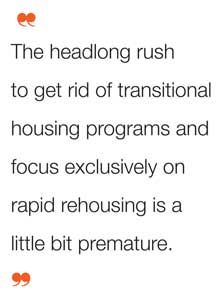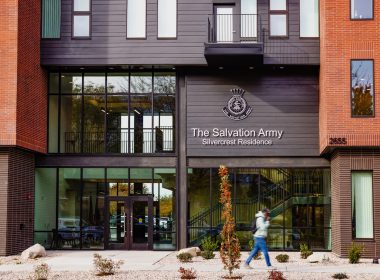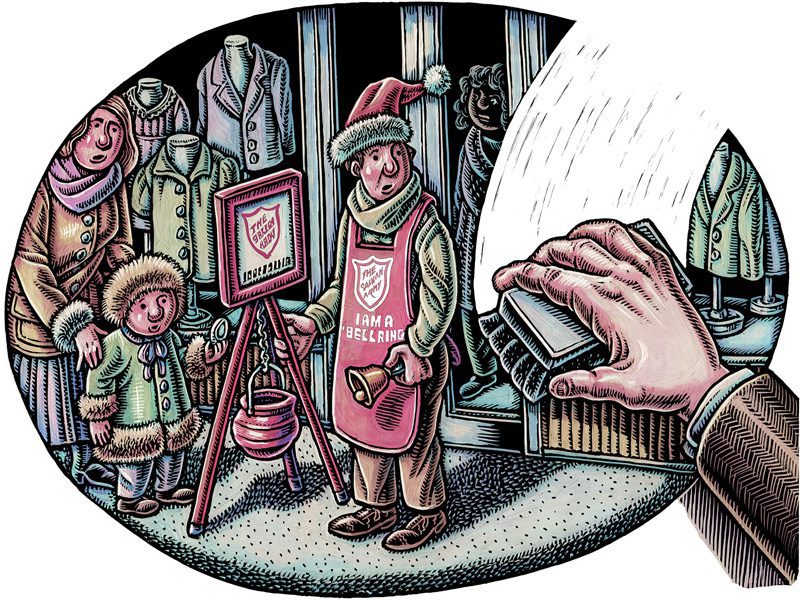The emergence of a new homeless intervention strategy may come at the expense of another.
By Jared McKiernan
The Department of Housing and Urban Development (HUD) is working to devise the best model for decreasing homelessness in communities across the country, and related funding could help determine the financial future of several of The Salvation Army’s transitional housing programs in the Western Territory.
Rapid rehousing, or “housing first,” denotes the effort to assign homeless individuals and families to permanent, supportive housing within 30 days. These initiatives appeal to HUD due to their low cost compared to transitional housing programs run by The Salvation Army as well as their ability to immediately remove families from the homeless list by putting them in permanent housing. Occupants of transitional housing facilities owned by The Salvation Army are still deemed homeless for the duration of their stay. There is also a two-year limit on these programs––which means that if these individuals do not stabilize within this period, they are back on the streets.something that
“The strategies used to work with the homeless population are evolving; they’re growing and they’re apt to change,” said Shawna Sampson, social services director for The Salvation Army in Spokane, Wash., where the Army has engaged a rapid rehousing program successfully enough to decrease the demand for transitional housing. “What used to be the prescribed intervention is no longer the case.”
 The Georgia Department of Community Affairs conducted a study this year on homelessness, concluding that a person who was served through transitional housing or an emergency shelter in Georgia was more than four times as likely to return to homelessness as a person served in a rapid rehousing program. Next year, HUD is set to release its own detailed study comparing the long-term effects of rapid re-housing with transitional and subsidized housing nationwide.
The Georgia Department of Community Affairs conducted a study this year on homelessness, concluding that a person who was served through transitional housing or an emergency shelter in Georgia was more than four times as likely to return to homelessness as a person served in a rapid rehousing program. Next year, HUD is set to release its own detailed study comparing the long-term effects of rapid re-housing with transitional and subsidized housing nationwide.
The Salvation Army Western Territory’s Northwest Division facilitates both rapid rehousing and transitional housing programs. Major Tom Walker, social services secretary for the Northwest Division, believes its transitional housing programs face an uphill battle.
“We have a lot of work to do to determine if the future of our [transitional housing] programs are viable,” Walker said. “We can anticipate that the funding is going to be going down for transitional [housing] programs.”
While more and more jurisdictions are weighing the benefits of rapid rehousing programs, Walker believes that a wholesale switch to rapid rehousing might be hasty, especially for metropolitan areas.
According to the Institute for Children, Poverty and Homelessness, rapid rehousing was New York City’s prevalent method for reducing family homelessness from 2005 to 2011. Over that period, approximately 33,000 families were moved out of a shelter. Yet, during that same period of time, the return-to-shelter rate increased.
“The effectiveness of the case management is something that hasn’t really been studied extensively yet,” Walker said. “The headlong rush to get rid of transitional housing programs and focus exclusively on rapid rehousing is a little bit premature.”
Walker added that Seattle, another metropolitan area, has actually seen increased need for shelters in the city with the emergence of rapid rehousing.
“Increasingly, if The Salvation Army wants to continue to do transitional housing, in our units with our programs, we’ll have to prove it’s more effective at ending homelessness than being in their own housing with our program or someone else’s program,” Walker said.
Former Spokane Corps Officers Majors Kyle and Lisa Smith recently helped launch the Homeless Families Coordinated Assessment, which allows families to come to one location where they’re assessed using an objective tool to identify what their barriers to housing are. Their score determines the best intervention or strategy to move them into housing.
“Data is indicating that the shorter amount of time you’re homeless, the more successful you’re going to be,” Sampson said. “Many families in Spokane are scoring for rapid rehousing. Families with fewer barriers are most likely going to go through rapid rehousing. We’re not seeing a whole lot of families score for transitional housing right now. Families with higher barriers to housing end up in transitional housing because they need more support.”
Other divisions in the territory are working to direct homeless individuals toward the most applicable intervention for them. Major Robert Lloyd, Clark County, Nev., coordinator, said that Clark County does offer permanent housing, but not via the rapid rehousing intervention. He, too, expressed skepticism for rapid rehousing as a panacea for homelessness.
“It can cause problems when you [immediately] put someone who’s been homeless for 10 years in permanent housing,” Lloyd said.
Aside from the chronically homeless population, he said that those struggling with addiction and mental illness may have difficulty securing permanent housing through this method. Once admitted into an addiction recovery program, individuals are no longer deemed homeless by the caseworkers, eliminating their chances at permanent housing.
“It’s difficult when you have someone chronically homeless who needs an [addiction] recovery program.” Lloyd said. “You get them in the recovery program, but by virtue of being in the program, they’re no longer homeless and they no longer qualify for the permanent housing.”
“Rapid rehousing is most effective for those who’ve recently lost their jobs, but it’s very little help to those with mental health issues.”
Many HUD-funded transitional housing programs come equipped with additional support services––a factor not typically accounted for when determining the cost-effectiveness and overall value of these programs. One of the Army’s transitional housing programs in the Northwest Division, for instance, offers resources for victims of domestic violence.
“Rapid rehousing has a lot going for it, but we think there’s value in our transitional housing programs,” Walker said. “There’s value in having women and their families who have decided to leave domestic violence and are trying to rebuild their lives in one place, meeting in support groups and working on their resumes and job skills, while they are around other people that know what it’s like. We think that there’s a value to that but we haven’t proven that there’s a value in that.”
Despite controversy surrounding which is the more practical method for alleviating homelessness in different regions, Sampson insists the two models can coexist––at least for the foreseeable future.
 “Rapid rehousing and transitional housing are not going to be changing tomorrow,” Sampson said, “but I do think that rapid rehousing is here to stay.”
“Rapid rehousing and transitional housing are not going to be changing tomorrow,” Sampson said, “but I do think that rapid rehousing is here to stay.”
According to Walker, one thing within The Salvation Army’s control can go a long way in solidifying the value of transitional housing programs.
“Research,” he said. “The Army should be engaged in researching the effectiveness of our own programs. The burden of proof is on us now to show that our way is more effective.”










